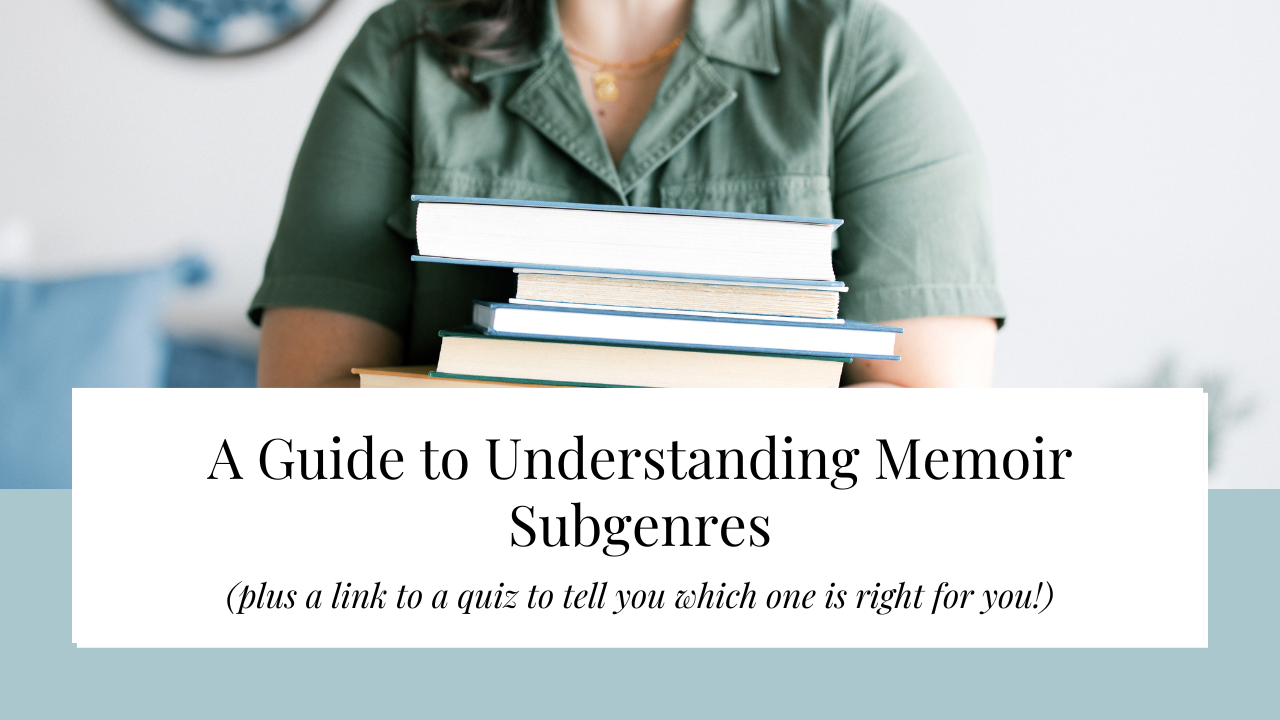A Guide to Understanding Memoir Subgenres
One of the first subgenre memoirs I remember reading is A Homemade Life by Molly Wizenberg. I was transported into her recollections and stories about her dad and how food played such a pivotal part in her childhood. The way she described food was decadent and made even this picky eater ready to go to a farmer’s market and buy obscure vegetables. This variation on memoir felt innovative (it likely wasn’t, but it was new to me), and changed how I saw the genre. Memoir, rather than a finite category of literature, is actually an umbrella for several subgenres that enhance the story and allow deeper connection to the reader.
Why memoir subgenres?
Often I’ll see writers ask some variation on the question, Is it okay if I do XYZ in my memoir?
Is it okay to include recipes?
Is it okay to talk about the medical industry alongside my experience?
Is it okay to use my memoir to advocate?
And I think it’s so funny that writers feel like they need to ask permission to write their story the way they want to write it, because here’s the thing: You can do whatever the hell you want with your memoir. This is your story, and you can write it the way you want to. Are there memoir conventions? Sure. Are they finite and unrelenting? Nope.
If you want to expand how you see the memoir genre (and how you might go about writing your own), scroll through these subgenres to get an idea of what’s possible for you.
Travel memoirs
A travel memoir is not only a collection of stories and adventures—it’s so much more than that! A well-written travel memoir will include lush descriptions of the place or places you’ve been and will also weave in your own personal transformation. The travel memoir serves as a window into another place, and also finds connection to the reader through your own inner experience.
Travel memoirs worth reading:
A Walk in the Woods by Bill Bryson
At Home in the World by Tsh Oxenreider
A Cook’s Tour: Global Adventures in Extreme Cuisine by Anthony Bourdain
Activism memoirs
In an activism memoir, the story is secondary to the message. The writer’s experience is a vehicle for making a larger statement about a problem in the world. The point of a social justice memoir is to raise awareness of a particular inequity or injustice. Activism memoirs are highly researched, using data and statistics alongside the author’s own story to make an impact and mobilize the reader.
Activism memoirs worth reading:
You’ll Never Believe What Happened to Lacey by Amber Ruffin
Just Mercy by Bryan Stevenson
Disability Visibility: First-Person Stories from the Twenty-first Century, edited by Alice Wong
Professional memoirs
A professional memoir focuses on your career, or on one specific job experience. These memoirs are ideal for hybrid memoirs (i.e., memoirs that intertwine your story with a behind-the-scenes of an industry, business advice, or self-help). The professional memoir occupies a unique place on the bookshelf, because not only does it tell the writer’s story, it also directly inspires and informs the reader.
Professional memoirs worth reading:
Maybe You Should Talk to Someone: A Therapist, Her Therapist, and Our Lives Revealed by Lori Gottleib
On Writing: A Memoir of the Craft by Stephen King
Save Me the Plums by Ruth Reichl
Spiritual memoirs
A spiritual memoir is a memoir of the inner life. This type of memoir doesn’t have to refer to any specific deity or religious creed (though it certainly could). The spiritual memoir is a story of being. Essay collections are well suited for spiritual memoirs, given that they are usually incredibly character-driven. While spiritual memoirs include anecdotes and accounts of lived experience, this type of memoir centers on the writer’s inner life while still making room for the reader to see themselves.
Spiritual memoirs worth reading:
I Miss You When I Blink by Mary Laura Philpott
I Am, I Am, I Am by Maggie O’Farrell
Hunger by Roxane Gay
Transformational memoirs
Of all the types of memoir you could write, the event memoir is probably the most adaptable and prolific. An event memoir chronicles a time-bound experience in your life. This could be a diagnosis, a divorce, a death, a birth, a coming-of-age experience, a move, or the beginning or end of a life chapter. This memoir bound by the event. You can include flashbacks for context, but the central narrative will be defined by one event or transformation. While your memoir will be specific to your experience, your reader will connect to your transformation and emotion, empowering them to lean in to their own transformations.
Transformational memoirs worth reading:
Educated by Tara Westover
Crying in H Mart by Michelle Zauner
Finding Me by Viola Davis
Other subgenres worth exploring
As I was writing this post, I thought of even more subgenres to include. Alas, time is finite, both mine and yours. I am, however, marking down these subgenres to explore in more detail later:
Food
Medical
Religious
Memoir-in-verse
Whatever more I (or you) identify!
A note on hybrid memoirs
Hybrid memoir is a term I made up, but feels appropriate for so many books I read. Many memoirs will overlap in subgenre: transformational with activism, professional with transformational, spiritual with religious. Remember that rules in writing and editing are made to be broken, so don’t be afraid to play around with form and content. If you want to have an idea of which type of memoir you would be best suited for writing, go ahead and take my Memoir Quiz!


